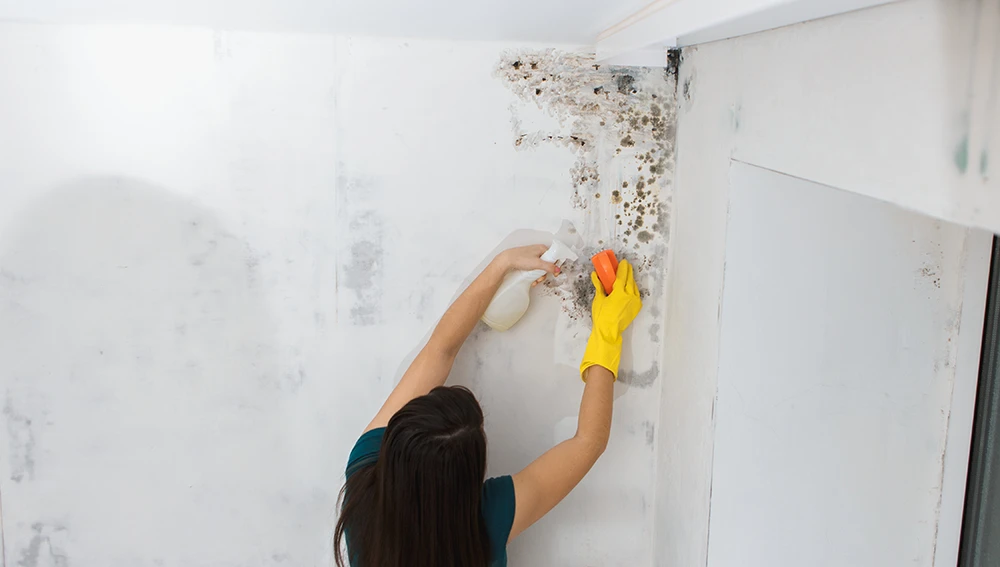Often, homeowners notice mold in the basement after snowmelt or during the rainy season. Typically, this is due to high humidity and poor ventilation.
It’s crucial not to underestimate the danger of this situation: if this type of fungus is not promptly addressed, active growth will begin. The facing material will deteriorate, pipes will rust, and wiring will fail. Moreover, it can harm the health of family members, ranging from developing rhinitis and asthma to pneumonia and severe allergic reactions.
Considering all circumstances, it’s important to find answers to the questions: What causes mold, and how to prevent mold in basement? We’ll help you with that by detailing the key points.
What Causes Mold in the Basement
The problem is somehow related to the high humidity level in the room. Add stagnant air and constant temperature, and you’ll get the perfect environment for mold growth. Various factors can contribute to this.
Flooding Incidents
Moisture can be caused by periodic flooding from groundwater and atmospheric precipitation. This is typical during periods of rain and snowmelt. Water can enter the room if there are cracks in the walls, foundation integrity is compromised, or joints are unsealed.
Inadequate or Improper Ventilation
Due to its location below ground level, the basement is a place with compromised ventilation. Poorly laid floor tiles or construction debris can block ventilation channels, worsening air circulation.
Accumulation of Condensation
Stale air, stable temperatures, and moisture all contribute to condensation forming on walls and ceilings. Its accumulation indicates that moisture is penetrating the building.
Presence of Damaged Plumbing Lines and Water Leaks
If the integrity of plumbing and heating systems is compromised, the risk of mold formation sharply increases. Even a small hole in a pipe can leak a large amount of water per day.
Incorrect Installation of Gutter Downspouts
When the gutter downspout is placed in the wrong location or at a steep angle, precipitation doesn’t collect in the drain. Instead, it lands on the walls and accumulates in the basement or foundation, leading to standing water and leaks.
Lack of Venting for Dryers
If you use a dryer, ensure it operates correctly. Issues with ventilation hoses can cause moisture buildup in various parts of the room.
Insufficient Drainage Systems
The reliability of the drainage system determines how quickly you can remove water in the event of a burst or flooding. A wet floor and walls will take a long time to dry, creating conditions for mold growth.
Any Other Conditions Contributing to High Humidity Levels
External insulation and waterproofing quality also affect the situation. There are also household factors, such as drying laundry inside or lack of lighting in the basement.
How to stop mold in basement? To understand this, you first need to assess the situation and determine the extent of the problem.
How to Check for Mold in the Basement
If you smell dampness or see condensation in different parts of the basement, there’s a high probability of encountering mold soon.
You can preliminarily determine the cause of the problem:
- Puddles on the floor due to rising groundwater levels and an unreliable drainage system.
- Moisture on walls and ceilings due to insufficient air circulation.
- Water droplets on walls due to compromised waterproofing.
These apply to situations where mold has not yet taken over the room. But what if the “uninvited guest” has already invaded your home? Let’s figure out how to recognize it.
Basement mold can manifest as fuzzy or slimy patches of yellow, green, brown, or white color. Its spores are airborne and settle on damp and warm surfaces, where they actively grow and reproduce. Colonies form, which, in turn, produce even more spores. The situation worsens.
Black mold in basement is particularly dangerous. Its health effects are comparable to carcinogens: there’s a risk of bone system damage and the development of lung and liver cancer. Interestingly, it can proliferate in low humidity and temperature.
If, after inspecting the basement, you don’t find signs of mold growth, do everything possible to prevent it from happening. We’ll discuss how to prevent mold next.
How to Prevent Basement Mold
If you’re looking for a comprehensive approach to protecting building structures from excessive moisture, consider interior waterproofing Toronto.
In any case, it’s worth taking measures that have already been tried and tested by many homeowners to solve issues.
Promptly Address Water Spills
Keep an eye on the basement’s condition, especially during heavy rainfall and rising groundwater levels. Invest in a quality drainage system and install reliable guttering to prevent precipitation from entering and accumulating in the basement.
Exercise Caution with Storage Practices
Extended exposure to high humidity conditions can cause clothes to develop an unpleasant odor and dark spots. The same applies to towels, blankets, bedding, and so on.
How to prevent mold on clothes in basement:
- Wash items regularly.
- Keep clothes dry.
- Store items in vacuum-sealed bags.
- Check for stains and odors.
- Air out the room.
Mold can also affect food items. For example, molds often choose vegetables and fruits as their habitat, while pink mold prefers grains. Food items should be periodically checked and stored in dry and cool conditions.
Minimize Clutter Wherever Feasible
Get rid of unnecessary items cluttering the space. Regularly clean all surfaces of dust and dirt. Promptly dispose of garbage, especially food waste and expired food products.
Regularly Inspect Gutters and Downspouts
Pay attention to the condition of the drainage and guttering system. Even if you’re confident in their reliability, it’s worth conducting at least a superficial inspection periodically. If problems are identified, consult with a specialist.
Swiftly Attend to Leak Repairs
Take action when there are first signs of pipe leaks. Conduct an inspection of plumbing and heating systems for damage yourself or call in a specialist. In any case, you’ll need the assistance of pipe repair professionals.
Utilize Bathroom Exhaust Fans
Install a ventilation system in the bathroom. This is important for maintaining optimal temperature and humidity levels, especially in the fall and winter months. The presence of an exhaust fan and its compliance with individual technical requirements determine the quality of air exchange.
Ensure Adequate Window Insulation
Avoid mold in the basement by using proper window insulation techniques (between the window and the wall), installing glass panels, applying silicone sealant in gaps, and clearing drainage holes.
Refrain from Carpet Installation
Avoid using carpets and rugs in dark, humid spaces. Otherwise, these items will quickly develop an unpleasant odor and characteristic stains that will be difficult to remove. This also applies to upholstered furniture.
Avoid Placing Plants in the Basement
A large number of indoor plants is a factor mold will appreciate, as plant soil requires constant moisture. Saprophytes (gray mold) can even affect plant seeds. Consider these factors when organizing the space.
Properly Insulate Water Pipes
To protect against condensation, block warm, moist air from reaching cold pipe surfaces. Thermal insulation is airtight and moisture-resistant, as well as resistant to mechanical damage.
Consider Mold-Resistant Paint
Use paints that meet international quality and environmental safety standards. It’s important for the product to have antibacterial and water-repellent properties and to create a coating resistant to mold in the basement.
Refrain from Storing Wood in the Basement
If you often use a fireplace, you’ve likely chosen the basement as the storage location for firewood. This is an optimal solution only if all conditions for wood are created there. Wood develops a musty odor, stains, and rots in a confined space with no air circulation.
What Steps Should You Take if You Discover Mold?
So, how to stop mold in basement:
- Prepare the area. Remove furniture, appliances, and stored items. Dispose of damaged items and food products.
- Clean the surfaces. Use a spatula or stiff brush to clean the walls, ceiling, and floor. Be prepared for the paint to be damaged – cosmetic repairs may be necessary later.
- Treat the affected area. Use a special solution, following safety rules. Also, treat a small radius around the affected area.
- Ventilate the basement and check the utilities. Ensure proper ventilation, plumbing, heating, drainage, and guttering systems.
Most importantly, make sure to control the humidity level. Contact specialists in interior and exterior waterproofing Toronto. They will conduct an inspection and help address issues related to water penetration into the premises.
Conclusion
When it comes to a problem like mold, don’t procrastinate. Do everything possible to prevent its appearance. If it has already invaded your home, thoroughly clean up with specialized products and seek assistance from building waterproofing professionals.
Contact us
Quality Age Build Inc is at your service across the GTA. Request a quote today and ensure your property is in expert hands.
Related Services
Pair our expert guidance with our waterproofing solutions to eliminate leaks, control moisture, and keep your basement dry and healthy.
FAQs
How can I tell if I have mold in the basement, and what are the signs to look for?
Regularly inspect the walls, ceiling, floor, and baseboards for black streaks or spots of yellow, brown, green, or white. Pay attention to any musty, earthy smell.
What are the health risks associated with mold in the basement?
These include asthma attacks, pneumonia, upset stomach, headaches, and nosebleeds. Mold irritates the mucous membranes of the eyes, throat, nose, lungs, and skin.
How can I control moisture levels in my basement to stop mold from growing?
Ensure proper air exchange, maintain the operation of drainage and guttering systems, fix leaks in water pipes, and insulate windows. Also, avoid placing plants and drying clothes in the basement.
What are the safest and most effective ways to remove mold from the basement?
It’s best to choose specialized products from reputable manufacturers. Always follow safety procedures when using them. Avoid preparing solutions yourself due to the danger of chemicals to the skin and mucous membranes.
How often should I inspect my basement for signs of mold?
Once a year or more often if your home has risk factors, such as an unstable ventilation system.

